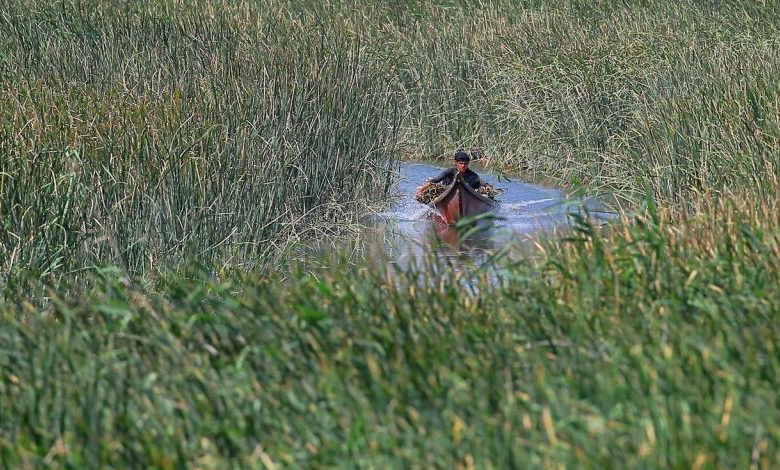A Quest for Endangered Otters in Iraq’s famous marshes

“Don’t move a muscle.” His command cut across the reeds rustling within the wind. On a moonlit embankment several kilometers from shore in Iraq’s celebrated southern marshes, everyone stood still.
Omar al-Sheikhly shined a flashlight across a muddy patch. “Nothing,” he said, shaking his head. His team of 5 exhaled in unison. The environmentalist spearheaded this midnight expedition through the marshes of Chibaish.
It is the newest during a quixotic mission that has spanned nearly two decades: to seek out any sign of Maxwell’s smooth-coated otter, a severely species endemic to Iraq whose precarious existence is significant to the long-lasting wetlands.
Most of al-Sheikhly’s pursuits are in vain; the quick-witted otter has always been one step ahead. But as global climate change looms, finding evidence they still exist assumes new importance. Al-Sheikhly is among the conservationists issuing a stark warning: Without quick action to guard the otters, the fragile underwater ecology of the UNESCO protected site are going to be disrupted, and will about wither away, putting in danger the centuries-old Iraqi marsh communities that depend upon it.
At stake is everything : “We stand to lose our Iraqi heritage,” said al-Sheikhly, who is that the technical director at Iraqi Green Climate Organization.
Studies indicate there are between 200-900 smooth-coated otters left within the marshlands. Dangerously unpredictable water levels, illegal fishing and neglect are driving their demise.
This year, Iraq is about to face an insufferable summer, with Turkish dam projects on the Tigris and Euphrates rivers compounding a year of low rainfall.
“There may be a real crisis,” Water Resources Minister Mahdi Rasheed al-Hamdani said this month.
Water rates from both rivers are half what they were last year, he said.
The Associated Press accompanied al-Sheikhly and his team on a 12-hour mission over two days in early May. At 8 a.m. on the second morning, al-Sheikhly was off again.
In long wooden canoes — called mashuf — they traversed narrow waterways lined with dense reedbeds crisscrossing the guts of the wetlands.
Jumping fish left ripples in their wake. Water buffalos languidly chewed grass. A kingfisher dove headfirst to catch unsuspecting prey.
As dragonflies chased his water-borne convoy, al-Sheikhly named whatever animal crossed his path as if they were acquaintances. “Marbled duck,” he pointed.
“Squacco heron.” He has been studying them for 18 years.
Finding the evasive smooth-coated otter is that the equivalent of winning the lottery. Since their discovery in 1956 by Scottish naturalist Gavin Maxwell, the otter, distinguished by its sleek dark fur and flattened tail, has only been photographed twice: when it had been first found, and 60 years later, by al-Sheikhly.
Locals had tipped him off that otters were seen within the a part of the marshes near the Iran border. There, on the remnants of an old military road forged by Hussein during the Iran-Iraq War , he waited for 6 hours. He saw the otter for less than some seconds.
Because research efforts are so poorly funded and otters themselves are so hard to seek out , studies about the species have relied on their dead skins for signs of life.
In January 2006, the fresh skin of an man was obtained from an area fisherman — it had been among the primary indications that the otter still thrived.
On this mission al-Sheikhly watched for signs they leave behind: footprints, discarded fish heads, local sightings. He goes to areas they like , like lakes lined with reedbeds and muddy shores.
In the central marshes of Dhi Qar province, his team happened upon two fishermen unloading the day’s catch. Al-Sheikhly stopped and asked them once they had last seen an otter — local observations are a main a part of survey efforts.
“Maybe one year ago,” said one, piling mullets, catfish and carp onto a pickup.
Al-Sheikhly furrowed his brow.
“That may be a big concern, if the area people sees them rarely it means something went on ,” he explained.
Their importance can’t be underestimated. To environmentalists, otters are referred to as “bio-indicators,” species wont to assess the health of a whole ecosystem. Because they’re on top of the organic phenomenon in Iraq’s marshes, eating fish and sometimes birds, their presence ensures balance.
There was a time when the otters were abundant.
British explorer Wilfred Thesiger, a up to date of Maxwell, wrote in his travel book Marsh Arabs about one occasion when he spotted two otters playing 100 yards away. “They appeared upright within the water, eyeing us for some seconds, before they dived and disappeared.”
In that moment, his Iraqi escort reached for a gun.
“Their skins were worth a dinar an article ,” he wrote. The durable otter skins were popular among smugglers who used them to move illicit goods.
Hunting is on the decline, but electric pulse fishing, illegal but widely practiced within the south, is partly responsible . the electrical pulse paralyzes the otter. Most die.
The fishermen who were questioned earlier each had electrocution devices on their boats, visible despite attempts to disguise them with carpets.
Al-Sheikhly said this might account for why otters are hard to identify . “Otters are smart, they know they’re under threat and alter their behaviors.”
Cruising through a good waterway, al-Sheikhly said that just last year the whole channel had been dry. Flooding re-filled it, but little rainfall this year threatens levels again. Experts said it’s already decreasing by one centimeter each day .
One local woman, Um Muntadhar, said when the water dries up, the birds migrate and her livestock dies. “It isn’t livable here anymore,” she said.
The UN estimates in any case 250 square kilometers (96 square miles) of fertile land in Iraq is lost annually to desertification. Rising salinity will likely drive out if not wipe off endemic species.
Iraqis largely blame Turkey’s Ilisu dam project for shortages. Turkish officials said Iraq’s request that Ankara release a group amount of water per annum is impossible within the age of global climate change .
“So much is unpredictable, we suffer,” said one Turkish official, who spoke on condition of anonymity.
In an open lake at the cusp of the Hammar marshes, al-Sheikhly halted the boat and quickly removed his shoes.
Threatened from all sides, environmentalists say it’ll take a miracle to push for conservation of the world .
But al-Sheikhly was absorbed in something unseen. “Listen, listen,” he said.












